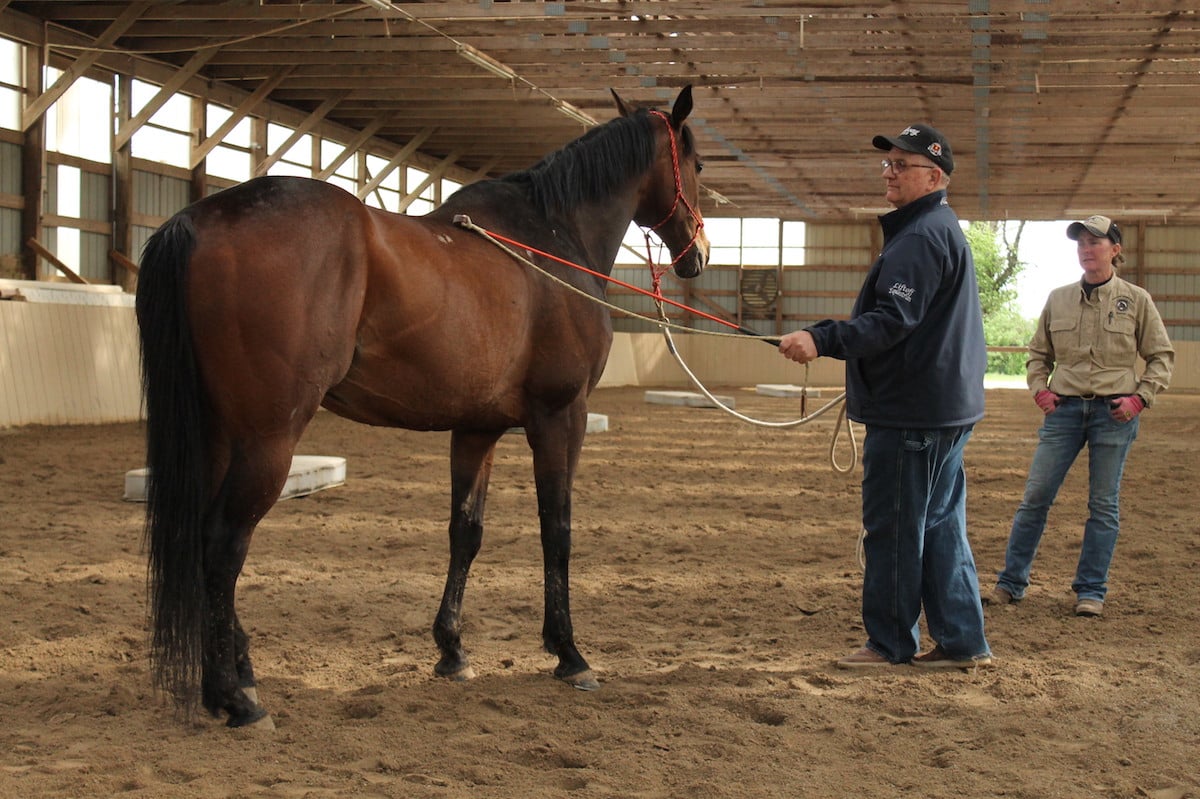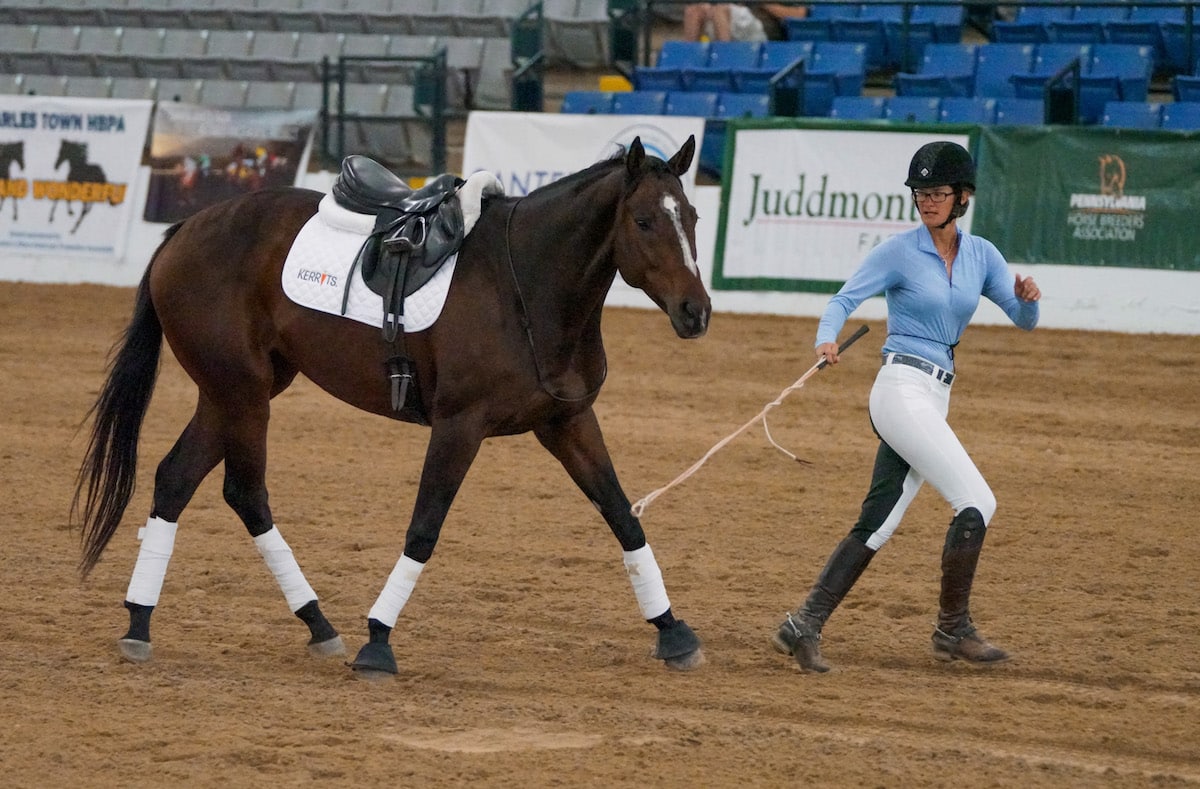Establishing connection, confidence and a foundation for your OTTB through groundwork

Kentucky Horse Park Mounted Police Captain Lisa Rakes guides a handler through groundwork basics with a newly retired racehorse. Stephanie L. Church/The Horse
You’ve found your new prospect freshly retired from the track, and you are eagerly looking forward to the Thoroughbred Makeover. But before you put your foot in the stirrup and swing up for that ever-important first ride, you might want to spend some quality time on the ground. As we move into winter, the cooler temperatures and slower pace of the season offer you and your new off-track Thoroughbred (OTTB) the perfect opportunity to get to know one another through groundwork.
When I trained horses professionally, I would spend however long I needed on the ground to establish a relationship with the horse. My typical routine would involve round pen work in the beginning, where my focus was on using body language to establish clear communication. From there I would usually introduce desensitization and problem-solving exercises and build on the horse’s level of confidence. The timeline and sequence of exercises varied depending on the horse, but all the groundwork gave me an understanding of his work ethic, how he accepted new situations and how he learned new concepts before I ever swung a leg over his back. This is especially useful for evaluating when a horse is truly ready to begin his transition to a new type of tack and work.
What Is Groundwork?
Groundwork is a broad term. Plainly speaking, it means using ground-based training techniques and body language to establish communication and encourage the horse to think. Groundwork can represent many different schools or approaches. It is typically used to describe the following activities, as well as other training techniques too numerous to mention:
■ Ground manners (leading, tying, grooming, bathing, picking up feet, loading, etc);
■ Establishing boundaries (teaching the horse to be respectful of your space);
■ Yielding the body (moving hindquarters or shoulders);
■ Responding/yielding to pressure and aids (rope, whip or stick); and
■ Desensitizing to new or busy environments and stimuli.
Groundwork is a key component for the Kentucky Horse Park (KHP) mounted police unit, in Lexington, which uses it extensively to prepare its officers (human and equine) for any challenges encountered on duty. KHP Mounted Police officers and groundwork clinicians Captain Lisa Rakes and Sergeant David Johnson both emphasize the importance of starting the relationship on the ground.
“Groundwork is not just longeing,” Rakes says, adding that it involves many things, including, “establishing boundaries, space, respect, as well as starting to introduce them to unfamiliar or spooky objects. You can do all that from the ground, so that you’re not interfering with them under saddle.”
“Groundwork is anything you’re doing on the ground,” adds Johnson. “That’s why I tell people, even when you walk into that stall or you walk out into that paddock, you should purposefully think about everything you’re doing. Anytime I’m around that horse I should be looking for it to be positive.”
Slowing Down the Mind
So how can groundwork be valuable for OTTBs? For Thoroughbreds, life in the fast lane often means their minds, not their bodies, are still racing even when they’ve left the backstretch behind. To make their transitions from the track as successful as possible, it is a crucial first step to slow their minds down and get them thinking about what they are being asked to do.
Lindsey Partridge of Harmony Horsemanship, in Ontario, Canada, has showcased her groundwork expertise over the years at the Thoroughbred Makeover, most notably as Freestyle champion in 2015 and 2016.
“Groundwork is a place where you can start a relationship, develop trust and address a lot of issues,” she says. “It keeps the human in a safer space and helps the horse be less reactive. It is also super helpful because sometimes horses have issues they have to heal from or stiffness that they need time off (for).”
Slowing the mind often helps slow the body, too. Thoroughbreds are typically intelligent horses with a will to please; using exercises to engage their minds and introduce problem-solving can provide a great foundation for riding exercises later.
“I always start my horses on the ground before I do any riding,” says Partridge. “It is an opportunity for the horse to learn how to be a good student, how to have emotional control and to let me see how the horses react to different situations and … learn different tasks.”
Training for Horse and Human
If you are new to groundwork concepts, start your education by working with an experienced individual and, preferably, an experienced horse. Understanding your own limitations as a trainer and acknowledging when you need help are important aspects of working with horses. Taking lessons, attending clinics, reading books and watching training videos from reputable sources are all useful for learning groundwork techniques and applications. But to gain skill, both KHP officers say it’s vital to get out there and start developing your feel and timing.
For “almost 98% of the people (we see for groundwork clinics), the problem they have is timing, whether it’s asking too long or giving up and not getting the response out of the horse or, once they get the horse going, they’re chasing the horse and not releasing that pressure,” Johnson says. “So they get the concept but, by the time they process it or get their body to do it, several seconds have passed and the timing is lost.”
Rakes also notes that persistence is key to success in groundwork. “People will watch the videos or go to the clinic, but then they just give up and they don’t just keep trying it,” she says. “Because they tried it one time and they think it didn’t work, but actually it didn’t work because their timing was bad or they didn’t read the horse right. But if they give it a try and hang with it and get themselves better, it works.”
Another important aspect of groundwork is adopting the appropriate training mindset. “Every time you’re around a horse, you are training,” explains Johnson. “It’s just a matter of whether you are training ‘good’ or you are training ‘bad.’ ” He also emphasizes the importance of not being in a hurry with these techniques but, rather, considering what is most reasonable to the individual horse and only going as fast as the horse can absorb.
Rakes agrees: “We train so many of our horses to become afraid. We just don’t realize it. But we teach them to become afraid because we try to force things too fast and don’t give them enough time to learn to accept it and realize that it’s nothing to be worried about. Be firm, but fair.”
Lastly, groundwork does not just offer an education for the horse but also can make you a better trainer and horseman. It builds the trainer’s self-confidence, says Johnson. “And then that confidence, the horse picks up on it.”
Set Them Up for Success

Groundwork has been a popular component of many Makeover Freestyle performances, including that of 2019 winner Amy Bowers and Grande Warrior. Canterclix
Most groundwork approaches involve using the application and release of pressure to shape a horse’s response or behavior. Horse training in general, mounted or not, regularly employs pressure and release. In a groundwork sense, one example would be swinging a rope toward a horse’s flank and stepping toward the horse (pressure stimuli) to evoke a response. When the horse steps away and yields his hindquarters (correct response), the person stops swinging the rope and stops stepping forward (release of pressure, or negative reinforcement) to reward the behavior. But simple pressure and release is only the beginning.
Knowing what question to ask the horse when and how takes groundwork to a higher level and increases the horse’s success rate by engaging his brain. Do not ask questions the horse is not ready to answer. This is setting the horse up for success on the ground and, later, under tack.
“Within the program we use calm connection exercises to help the horse to get into a thinking frame of mind,” Partridge says. “These exercises also exist while riding in the saddle, so it helps to transition the horse into riding work when the time comes. After we develop a thinking frame of mind, then the program teaches the horse their ABCs and how to condition the ‘yes’ response using positive reinforcement (giving a properly timed treat or a scratch when the horse performs a task correctly). I much prefer this training technique than using excessive pressure and release.”
Explaining the Aids
Groundwork can provide a direct link to ridden exercises and establish a confident foundation under saddle. Many trainers use in-hand work to introduce turn on the forehand, leg yield, shoulder-fore and shoulder-in and ground driving. Explaining the aids first on the ground in a way the horse already recognizes can provide a smoother transition to those ridden concepts. This is an excellent opportunity to help the horse understand his new relationship with the bit, with contact, and learn how to isolate and move different parts of his body. This also allows for steadier and smoother progress under saddle.
When using groundwork or more focused in-hand exercises, use as little tension or pressure as possible. For instance, to introduce the concept of the leg yield, you want the horse to yield the hindquarters and step forward and under with the inside leg (the one on the side where you’re standing), while establishing a soft inside bend. To do so, you might step toward the horse’s rib cage, swinging a rope to create the inside bend, rather than pulling on the halter or inside rein to create the shape. This simulates the horse responding to and bending around the inside leg aid. The inside hind steps under and hindquarters yield away from the pressure as the horse steps forward.
Good groundwork can also help start building topline muscle and strength in the hindquarters, preparing the former racehorse’s back for better self-carriage and ridden work later.
Properly executed, groundwork can provide a valuable foundation for OTTBs as they transition into their second careers. It slows their mind, encourages them to think rather than just react and helps provide greater understanding of ridden aids. It increases communication and confidence between horse and human. If you have not already incorporated groundwork into your retraining process, consider giving it a try and seeing how it can benefit your new partnership.
This article was originally published in the Winter 2020 issue of Off-Track Thoroughbred Magazine, the only publication dedicated to the Thoroughbred ex-racehorse in second careers. Want four information-packed issues a year delivered to your door or your favorite digital device? Subscribe now!

